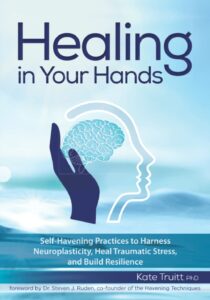Related Resources
For Havening Techniques®
Self-Havening Guided Practice for Enhancing Calm and Wellness
CPR for the Amygdala is an easy and accessible tool for helping your Amygdala (reactive brain) calm down in a moment of stress, anger, or anxiety. In this video Dr. Truitt will guide you through the self-havening touch and CPR for the Amygdala exercise.
An Introduction to the Havening Touch
Dr. Kate Truitt introduces us to the havening touch in this psychoeducational video. She begins by explaining that havening touch can actually shift the way our brain is functioning in the moment. We have the ability to actually shift the electrochemical experience of our brain. This simple touch doesn’t require a lot of executive function or attention while we do it. Our brain can be engaged in other cognitive exercises at the same time, which empowers the Havening Techniques.
Let’s Talk Trauma
Dr. Kate Truitt begins by speaking to us about the full associated playlist, which covers the intricacies of trauma, such as post traumatic stress injury and complex trauma. We will also be addressing questions such as why do some people have PTSD and others don’t? How many adverse childhood experiences do we have? What does trauma do to the brain?
Navigating Trauma – How to Build Your Emotional Safe Space with the Healing in Your Hands Programs with Self-Havening Exercises
Trauma creates change you don’t choose. Healing is about creating change you do choose.
By Dr. Kate Truitt
Trauma can leave us feeling vulnerable, powerless, and disconnected, both from ourselves and from others. In all its forms, trauma leaves an impact on our lives and affects us in countless ways. The opportunity for healing comes with knowing that you have the power to create your safe space and create healing from within.
A powerful set of self-healing tools that can aid us on this journey are the Healing in Your Hands Programs, a powerful new way to partner with your brain in order create healing and build personal empowerment. The Healing in Your Hands Programs, grounded in scientific research and compassionate care, offer us a pathway to create personal safe spaces and navigate the complex landscape of trauma, stress, and other painful emotional experiences. One of the mechanisms of actions in the Healing in Your Hands Programs is the Havening Touch. If this is your first time hearing about the Havening Touch, I invite you to watch the short 5-minute clip on the sidebar of this article: An Introduction to the Havening Touch with Dr. Kate Truitt.
The Impact of Trauma

When we go through a traumatic experience, it can leave a lasting impact on our emotional, physical, and psychological well-being. That’s why it’s important to explore how trauma affects us so that we can better understand and cope.
Types of Trauma
There are different types of trauma but for now, let’s divide them into three main groups–acute, chronic, and complex.
Acute trauma refers to a single, highly distressing event, such as a car accident or an act of violence. These experiences can leave us with immediate shock and disbelief, often leading to symptoms like flashbacks, nightmares, and heightened anxiety.
Another form of trauma is chronic trauma, which involves repeated and prolonged exposure to distressing events, such as ongoing abuse or neglect. This type of trauma can have deep, long-lasting effects on our sense of self, relationships, and overall well-being.
Then there’s complex trauma, which typically occurs during childhood and involves multiple traumatic experiences within the context of a caregiving relationship or a prolonged adverse environment. Complex trauma can severely impact our development, leading to difficulties in emotional regulation, attachment issues, and challenges in forming healthy relationships.
If you want to learn more about trauma, you can watch this YouTube video. It’s the first of YouTube video series, where you can learn about the intricacies of trauma and gain access to guided meditations and healing exercises.
Remember that trauma is unique to each individual. We all have different coping mechanisms, resilience levels, and support systems that can influence how we respond to and recover from traumatic experiences.
Recognizing Trauma
It’s incredibly important to recognize trauma in ourselves and others because it can have a significant impact on our lives and overall well-being. When we experience trauma, it can leave us feeling a range of uncomfortable emotions, like fear, anxiety, and distrust, especially toward others and ourselves. These feelings can make it challenging to feel safe, secure, and in control of our lives.
However, by recognizing and acknowledging our trauma, we can begin to create our personal safe space. This safe space looks different for everyone and can come in various forms, such as seeking professional help from a mental health specialist, practicing mindful self-care techniques, and finding a supportive community. Creating a safe space can help us feel in control of our lives again, providing a sense of comfort, healing, and growth.
Creating Your Personal Safe Space

Creating safe spaces is a vital aspect of our healing and recovery journeys. These environments provide us with the support, comfort, and security we need to navigate the challenges we face. But did you know you can also create your safe space from within? And you can do this by integrating Havening Techniques into your healing journey.
The Healing in Your Hands Program:
The tools within “Healing in Your Hands,” along with the comprehensive theoretical self-havening framework, are rooted in neuroscience. They employ a gentle, mindful touch to affect changes in the brain’s neurochemical balance. By incorporating slow and rhythmic touch into various cognitive, emotionally-focused, and neuroplasticity-based protocols, we’re given a neurobiological opportunity to reframe traumatic memories, reducing the distressing sensations encountered when recalling them. Watch this Self-Havening Guided Practice for Enhancing Calm and Wellness in the sidebar of this article so you can start experiencing the benefits of self-havening right now.
The Havening Touch generates slow brain waves, known as theta and delta waves, in the brain, which are associated with relaxation, safety, and healing. This leads to a decrease in the levels of stress hormones and an increase in the levels of feel-good neurotransmitters, such as oxytocin, GABA, and serotonin. These electrochemical changes in the brain are why both the Healing in Your Hands Programs and clinical interventions of the Havening Techniques are effective in helping create a safe space from within and reduce the impact of trauma.
Remember that a safe space is where you feel comfortable, in control, and able to freely express yourself without judgement. This safety and comfort then leads to a reduction in feelings of anxiety and fear.
By learning and practicing the different Healing in Your Hands exercises, you can take control of your well-being and better engage in your healing process. The good thing is you can also do this anytime and anywhere, offering you a sense of control over trauma and the effects it may have on your daily lives.
And if you want to learn more about this healing tool, I wrote a separate blog which delves deeper into The Havening Techniques: New Neuroscientific Insights Shine Light on Ancient Healing Practices.
If you’re experiencing symptoms of PTSD, panic, dissociation, or other disruptions, please seek support from a licensed professional. The clinical component of the “Healing in Your Hands” programs, known as the Havening Techniques, is a potent neurobiological toolset for facilitating long-term and sustainable healing. Contact us today or, if you’re a healing professional, join us at an upcoming training or workshop to start integrating these tools into your practice today!
More Tips on How You Can Create Your Emotional Safe Space

- Create opportunities for emotional expression within your safe space.
Create opportunities for emotional expression within your safe space. Write in a journal, engage in art or creative endeavors, or play calming music that resonates with your emotions. Expressing your feelings can be cathartic and provide a sense of release and relief.
- Learn and practice emotional regulation.
Learn and practice emotional regulation techniques that work for you within your safe space. This can include mindfulness exercises, deep breathing, or guided meditations. These techniques can help you calm your mind and regulate your emotions when you’re feeling overwhelmed or anxious.
- Cultivate positive resilience anchors – building glimmer moments.
Consider incorporating objects or rituals that evoke positive emotions and a sense of safety. This could be a comforting scent, a symbol that represents strength, or affirmations that remind you of your resilience. These anchors can help ground you during moments of stress or emotional turbulence.
- Be compassionate with yourself.
Cultivate an attitude of self-compassion and acceptance within your safe space. Embrace your vulnerabilities, acknowledge your emotions without judgment, and practice self-kindness. Allow your safe space to be a haven where you can honor and nurture your true self.
Building your emotional safe space is a deeply personal and ongoing process. And by recognizing trauma, you are empowered to take steps toward your healing journey. This process can be challenging and may require support, but it’s important to remember that healing and change are possible. And remember, through the power of touch in Havening Techniques, you have the power and opportunity within you to create that space where you’re free to hold space for yourself as you navigate your healing journey.
Resources for Understanding Trauma and Havening Techniques
If you’re looking for more support on your healing journey, be sure to check out the following:
- Join our community by subscribing to our YouTube channel where you can get psychoeducational content, guided exercises and meditations to help you in your healing journey.
- Connect with me on TikTok where I upload daily videos answering questions about mental health, trauma, and psychology.
- And in my book, Healing in Your Hands, I dive deep into the neuroscience of trauma, sharing client stories, healing tools, and exercises you can use on your journey to heal the past, create the present, and build the future you want.

We also offer the following services
Use code HEALING to get 30% OFF.
To help you learn more about this topic, here are all of the resources I mentioned in this post:
- Self Havening Guided Practice for Enhancing Calm and Wellness with Dr. Kate Truitt [YouTube Video]
- An Introduction to the Havening Touch with Dr. Kate Truitt [YouTube Video]
- Let’s Talk Trauma with Dr. Kate Truitt [YouTube Video]
- Trauma [YouTube Playlist by Dr. Kate Truitt]
- The Havening Techniques: New Neuroscientific Insights Shine Light on Ancient Healing Practices [YouTube Video]
References
Ruden, R. A. (2016). When the Past Is Always Present: Emotional Traumatization, Causes, and Cures. Routledge.
Reutter, K. (n.d.). Mindfulness Skills for Trauma and PTSD: The Safe Place, the Container, and Mindfulness Reflections. Retrieved Oct 16, 2023, from https://psychotherapyacademy.org/section/mindfulness-skills-for-trauma-and-ptsd-the-safe-place-the-container-and-mindfulness-reflections/
Resources
- Self Havening Guided Practice for Enhancing Calm and Wellness with Dr. Kate Truitt: https://youtu.be/rl0hrGLnWeM?si=hjUkpSp4dAy5vpbU
- An Introduction to the Havening Touch with Dr. Kate Truitt: https://youtu.be/iTMTsmHHYnM?si=dh_VWKtiGJzUqtE-
- Let’s Talk Trauma with Dr. Kate Truitt: https://youtu.be/Qs8qnL_YGb8?si=37XPT8EwHT-MQYbj










